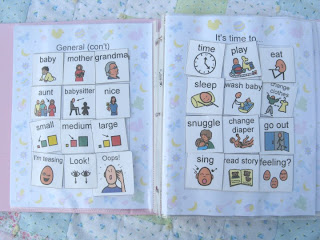After posting last week about how we can help our kids build communication skills during play, I thought you might want to see a sample vocabulary notebook. Today I’ll show you some example pages and talk you through building play vocabulary at home.
My sample activity is a “baby book” I made years ago as a gift for my daughter and the new baby Annabelle doll Santa brought her. In keeping with the play theme, I used special paper printed with nursery items and made an “intro” page for pictures and the baby’s “birth” information. We want this to be fun and tickle the imagination! What kind of fun, theme-oriented storage could you use for your child’s favorite play activity?
I began by brainstorming all the activities my daughter might want to do with her doll. Hmmmm, what do other little girls do with their dolls? They feed them, rock them to sleep, change their outfits, give them pretend baths, play imaginary games with their babies…the list goes on and on!
Then, with one major activity in mind at a time, I began to think about the sort of things a little girl might need to help her baby (a diaper, a dress, a bottle, a blanket) and the actions she would carry out on her own (snuggle, feed, lather, etc.). Those would become the words my daughter would use to direct me to help her act out with her doll. Of course, we need to know how baby is feeling, so there are lots of feeling choices, and comments and questions a junior mama would say to her doll, such as commenting about baby’s dirty diaper being “stinky” or telling her baby “sh-h-h,” time to “settle down.” Baby, why are you “crying?” Do you want to “read [a] story?”
Next came time to make symbols. When I made this sample, I wasn’t yet using colored borders; sorry about that! My daughter typically needs loose symbols, so I cut out individual symbols after they were cold-laminated (no fear of edges peeling with cold laminate). Hook-side Velcro went on the backs.
To keep the symbols organized, I printed labeled grids on sheets of the pretty nursery paper, slid them into plastic page protectors, and stuck loop-side Velcro on the squares. This makes it easy to put the symbols back where they belong and see right away if any are missing (check your socks, your sweater, the dolly’s outfit…it’s probably stuck to one of those).
To keep the symbols organized, I printed labeled grids on sheets of the pretty nursery paper, slid them into plastic page protectors, and stuck loop-side Velcro on the squares. This makes it easy to put the symbols back where they belong and see right away if any are missing (check your socks, your sweater, the dolly’s outfit…it’s probably stuck to one of those).
So, what if your little one doesn’t play with dolls? In a nutshell, you would simply go through these same steps to create a vocabulary notebook for your child’s favorite playtime activity:
1) Think about how typically-developing children carry out the play activity. What situations do they create? What things do they say? What motions do they make?
2) For each main category, brainstorm a list of words that includes:
· Things needed in the activity (car, road, stop sign…)
· Actions that happen during the play (race, drive, crash, stop…)
· Feelings the players have (mad my car got hit, excited I won the race…)
· Comments (and sound effects!) that fit the scenarios (I won! Good race, Lightning!, Oh no, Vrooom!!!)
· Questions related to the play (Race again? Ready? Need gas?)
3) Make your symbols and a creative, playful way to store them that inspires the imagination. A simple frame of activity-related clipart can dress up plain storage pages and a clever cover will help your child identify the communication book when it’s time to play.
Keep in mind that your child will not be able to use all this new vocabulary at once! It takes repeated exposure during play, especially if the vocabulary words are not used across his day. But you can use them expressively to model the conversation skills you hope your child will one day master. Trust your child; he is taking in more than meets the eye!
Now, for the GIVEAWAY! If you know a little girl (or little ones in a classroom) who would love a way to be able to communicate with and about her doll, head over to the Doll Play Communication Book Giveaway page for your chance to win the sample notebook from this post. This might just be the ideal giveaway for you!
* * * * * * * * * * *
Other posts related to this topic:
Building Communication Through Play
Getting Ready for Non-Verbal Communication
Eye Gaze Techniques
* * * * * * * * * * *
Other posts related to this topic:
Building Communication Through Play
Getting Ready for Non-Verbal Communication
Eye Gaze Techniques






No comments:
Post a Comment